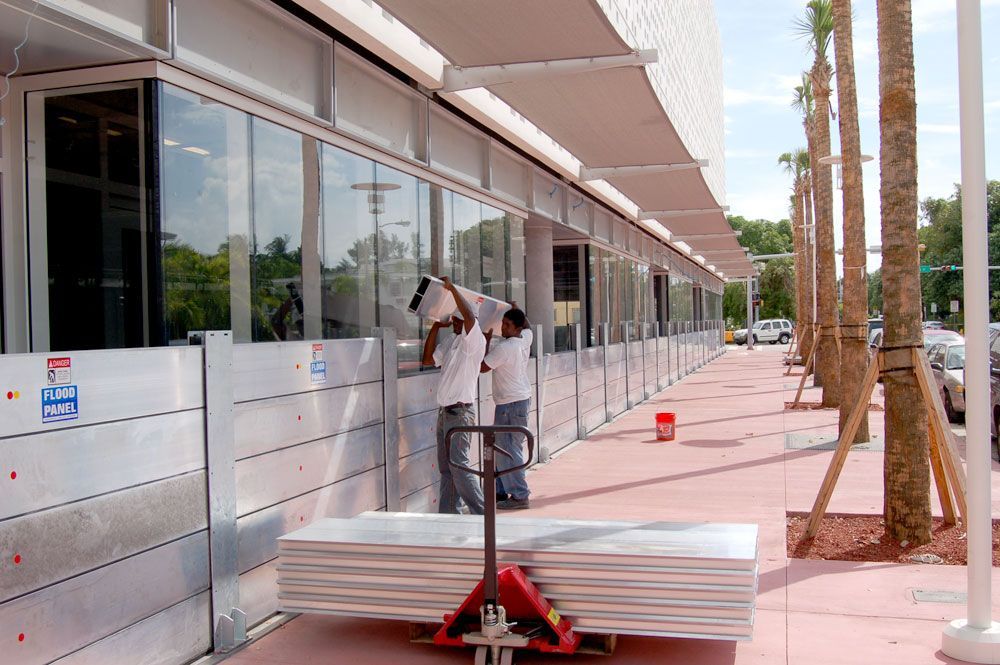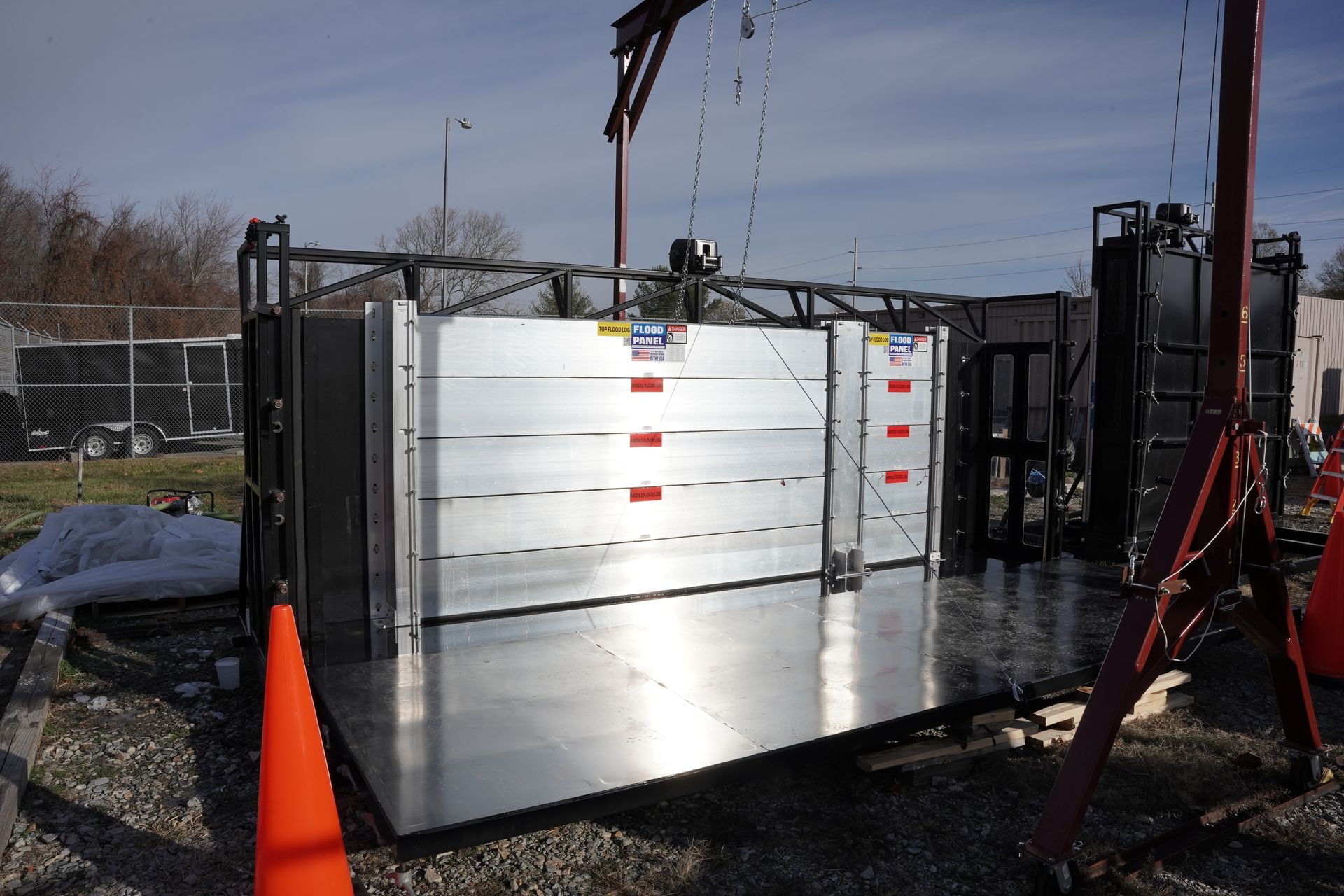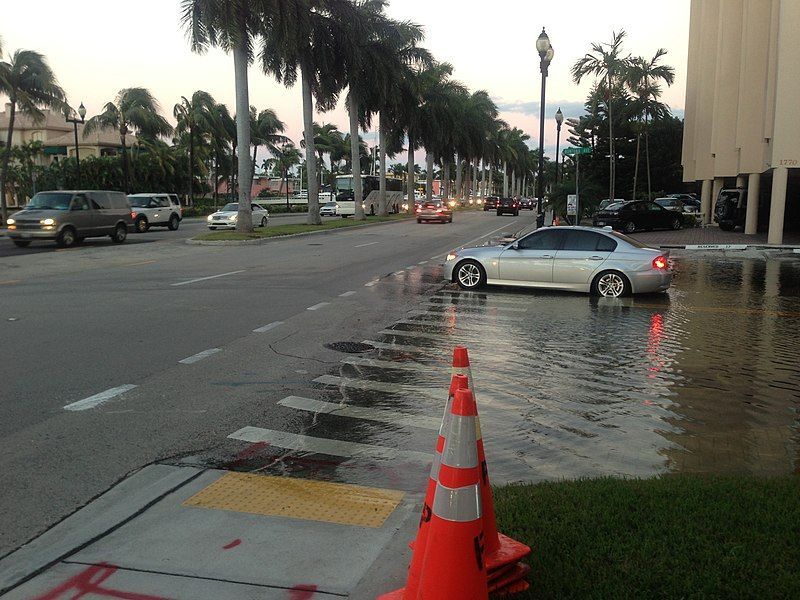Call Us Today - 1 (860) 222-3055
Page 11
Media Contact
Email: media@floodpanel.com

Flood Solutions for Commercial Construction
Flood Panel designs high-quality flood protection solutions for commercial construction projects to suit most flooding scenarios. Popular solutions include:
- FloodPanel™ – an economical and effective flood barrier system made of industrial strength metal and compression seals to protect building entrances of any width and height.
- FloodLog™ – a modular flood barrier system designed to meet and exceed heavy water loads and impact forces, like those from a rushing river or a hurricane. This stackable, high-grade aluminum product can be made for most heights or lengths. FloodLog uses proprietary technology that enables the logs to glide into rails for easy installation. The installation design can also be customized for aesthetic appeal or rapid deployment.
- Puddle Panel™ – a quick-reaction barrier system capable of withstanding flooding that is less than two feet deep and is extremely effective for doorways. The lightweight aluminum system is edged with a thick rubber gasket, which creates a waterproof seal on the door opening when used with the stainless-steel mounting plate. Installation time for a single or double door is under five minutes.
For more information and to learn how businesses are using Flood Panel solutions to protect their commercial assets before the next flood, visit Flood Panel at www.floodpanel.com.
At the time of the last post, Hurricane Harvey had pounded the Texas coastline with high winds and lashing rain. Witnesses reported that the rain in their faces felt like the output from a power washer, and every drop caused stinging pain. By the time the storm had dissipated, many longstanding flood records had been smashed, Houston was underwater, and hundreds of thousands of people had been driven from their homes.
The amount of rainfall from this storm was simply astonishing. Precipitation levels during the three days of the storm were measured in feet, not inches. The previous record for flooding in Buffalo Bayou, which stretches into Houston, was bested by 14 feet! Many areas received an entire year’s worth of rainfall in a couple of days. The worst fears of local people were surpassed, and by a lot. And even when the rain had finally stopped, the flooding had not. The flooding after the storm came from two reservoirs that had been built to prevent the very situation they were now causing!
Originally, the Addicks and Barker reservoirs were built well outside of Houston, in an area that was relatively undeveloped. The intention was that the reservoirs could contain a massive amount of precipitation during hurricanes and large storms, leaving the Houston metropolis protected. In recent decades, however, developers have been permitted to sprawl new communities right up to the massive earthen berms that hold back the billions of gallons of water. On the far side of the lakes, new neighborhoods rise up from the banks … but without sufficient elevation to escape inundation when the lake level rises.
Enlarged map of rainfall from the hurricane in the Houston and Beaumont metropolitan areas in southeast Texas. Areas in yellow indicate accumulations in excess of 40 in (1,000 mm). Image: David M. Roth; NOAA WPC
During Hurricane Harvey, these two lakes filled to the point where the water could no longer be contained at all. The water had to go somewhere: it had to either be released through the emergency sluice gates, rise up into the neighborhoods that ring the lakes, or flow over the berm itself. At some point after the storm, all three of these things were happening in an uncontrolled fashion. At this point, the Army Corps of Engineers (ACE), who operate the reservoirs, made the only decision they could make: the gates were fully opened to drain the lakes. The ACE now estimates that the gates will need to remain open for weeks, if not months … all the while continuously flooding homes in the path of the lakes’ surplus water.
What happened? How is it that the plan to protect Houston resulted in disaster to so many?
Most of the homes that enjoyed a lake view for so many years are now underwater, and will remain so for the foreseeable future. Sadly, many of these homes are not covered by flood insurance, because it was not legally required in the “500-year floodplain” where they are situated. But disastrous planning (or lack of it) resulted in huge swaths of watershed areas that were paved, covered by homes, driveways, patios, parking lots, swimming pools, basketball courts, streets, and other surfaces that shed water rather than safely absorb it.
All this poorly-planned development was permitted to cover the formerly green zones that surrounded the lakes, and now MUCH more water than before is being dumped into the lakes as it runs off the impermeable surfaces. This situation, combined with the fact that 500-year floods have been occurring with alarming frequency, means that owning one of these lake-view homes is anything but enviable. Texas, known for its distaste for government regulation and federal “interference” is now learning the price of rampant, unregulated growth.
Source:: FloodBarrierUSA
Anyone landing at the Houston International Airport on a clear day will enjoy a sweeping view of the coastline, as well as the spit of sand called Galveston Island. The Gulf of Mexico looks serene on a day like that, and the beaches look welcoming and bright — even from an altitude of 30,000 feet. But one can’t help imagining what might happen to all that low-lying coastline, crowded with homes and business, if it were to be struck by a major hurricane. In late August 2018, just that happened.
Hurricane Harvey approached the Texas coast as a relatively meek tropical storm, having spent itself and reformed several times during its trip through the Caribbean. Unfortunately, just before the storm made landfall in southeastern Texas, it intensified into a full-blown Category 4 hurricane with tornado-like winds inside the storm. This would not be the minor storm residents and officials had hoped for — it would be a very, very dangerous hurricane. Mandatory evacuations were quickly ordered, and Texas Governor Greg Abbott drove home the seriousness of the situation when he advised all those who ignored the evacuation to print their name and social security number on themselves, so that they could be more easily identified.
Hurricane Harvey near the coast of Texas at peak intensity late on August 25, 2017. ABI image captured by NOAA’s GOES-16 satellite.
Even this dire advice did not dissuade many residents who rode out the storm in vulnerable houses, flimsy trailer homes, and even boats! Some of these people wished to remain with their belongings, while others were too poor or infirm to evacuate. Most immediately regretted their decision to stay, and witnesses described a veritable tsunami-like wall of water and wind that sounded like a jet engine. At that point, there was nothing to do but hang on and hope for the best. When the calm eye of the storm passed over the coastline, many people who had been blasted by the storm scurried out of hiding to seek stronger shelter, but very soon the eye was followed by the second wall of the hurricane. Once again, the winds, rain, and storm surge hammered the coastline with a force that was beyond belief. When the storm had finally passed, many of those who had survived the storm were deeply traumatized
In this part of the world, it has been almost a decade since any major storm — not since Hurricane Ike in 2005 had any hurricane hit Texas. And we would have to look back a full 56 years to recall a hurricane of similar intensity — Hurricane Harvey will remain indelibly burned on the memories of every last person who lived through it. The stats of the storm beggar belief: over four FEET of precipitation fell in some places, and many spots received the equivalent of a full year’s rainfall in a couple of days!
Adding to the destructive power of the wind and rain is a substantial storm surge of over 6 ft. A storm surge is a massive wall of seawater that is mounded up by the storm and slammed onto the coastline. A surge of this size can overwhelm flood barriers, sea walls, and other flood defense measures; leaving homes and other buildings inundated. In fact, it is the flooding that caused the most damage in the Houston area. Officials warned that the weakened storm would turn around to drift back over the same ground. It became a slow-moving storm, without the destructive winds it once had, but still FULL of rain. It dumped even more precipitation on the already flood-ravaged zone.
Next post: Floods Ravage Houston
Source:: FloodBarrierUSA
According to a Special Report by NBC News, recovery in many New York neighborhoods continues five years after Hurricane Sandy devastated much of the coastline. “A crucial question remains: Is the groundwork being laid enough to protect America’s most populous city from future floods, extreme weather and rising sea levels?”
It seems New Yorkers are willing to take the gamble. Resiliency projects abound across the city in preparation for the next superstorm, including new bulkheads and barriers, concrete esplanades, retaining walls, dunes and marsh restorations. Funding is another issue, especially as the federal government challenges the threat of climate change despite new research that shows storm-related floods could be more intense and frequent in the next 10 years.
Read the full story here: https://www.nbcnews.com/news/us-news/5-years-after-sandy-are-nyc-s-preparations-amid-climate-n812221

Tell us about your project
We look forward to the opportunity to earn your business and to become a value-added partner on your design and construction team.
Contact Us
Contact Us
Phone:
1-860-222-3055
Address: 1555 Jupiter Park Drive, Suite 5, Jupiter, FL 33458

